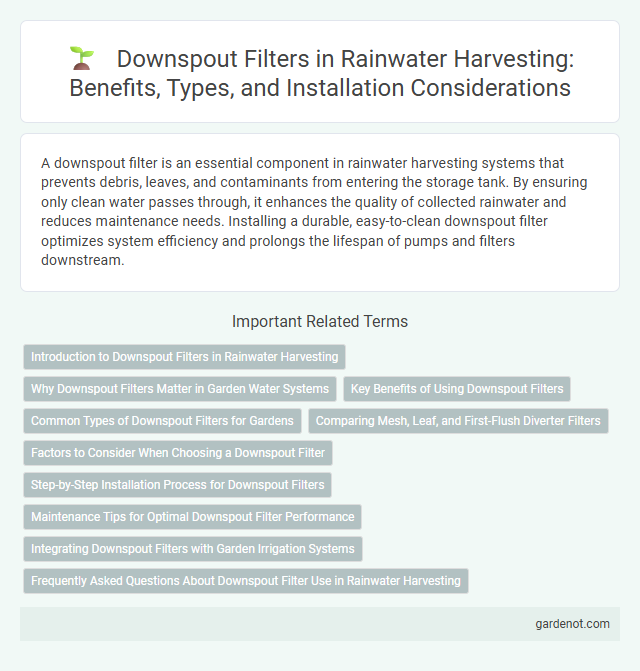A downspout filter is an essential component in rainwater harvesting systems that prevents debris, leaves, and contaminants from entering the storage tank. By ensuring only clean water passes through, it enhances the quality of collected rainwater and reduces maintenance needs. Installing a durable, easy-to-clean downspout filter optimizes system efficiency and prolongs the lifespan of pumps and filters downstream.
Introduction to Downspout Filters in Rainwater Harvesting
Downspout filters play a crucial role in rainwater harvesting by preventing debris, leaves, and contaminants from entering the storage system. These filters enhance water quality and reduce maintenance by trapping particles before water reaches the storage tanks or barrels. Effective downspout filters can significantly improve the longevity and efficiency of rainwater collection systems in residential and commercial applications.
Why Downspout Filters Matter in Garden Water Systems
Downspout filters are essential in garden water systems because they prevent leaves, debris, and contaminants from entering rainwater storage tanks, ensuring cleaner water for irrigation. By reducing sediment and organic matter, these filters protect pumps and plumbing from clogging and damage, enhancing system longevity. Efficient downspout filtration supports sustainable water use, promoting healthy plant growth and minimizing maintenance costs.
Key Benefits of Using Downspout Filters
Downspout filters effectively remove debris, leaves, and contaminants from rainwater, ensuring cleaner water for harvesting systems. These filters reduce the risk of clogging in storage tanks and irrigation equipment, enhancing system longevity and performance. By improving water quality, downspout filters also help prevent algae growth and protect plants when used for gardening or landscaping.
Common Types of Downspout Filters for Gardens
Common types of downspout filters for gardens include mesh screens, first flush diverters, and leaf catchers, each designed to remove debris and prevent clogging in rainwater harvesting systems. Mesh screens effectively filter out leaves and large particles, protecting storage tanks and irrigation equipment. First flush diverters improve water quality by discarding initial runoff containing contaminants, while leaf catchers trap organic debris before water enters the collection system.
Comparing Mesh, Leaf, and First-Flush Diverter Filters
Downspout filters are crucial for effective rainwater harvesting by preventing debris from entering storage systems. Mesh filters excel in trapping small particles but require frequent cleaning, while leaf filters efficiently block larger foliage with minimal maintenance. First-flush diverter filters optimize water quality by discarding initial runoff containing contaminants before the cleaner water reaches the tank.
Factors to Consider When Choosing a Downspout Filter
Selecting the ideal downspout filter for rainwater harvesting involves evaluating filtration efficiency, material durability, and maintenance requirements to ensure optimal performance and longevity. Consider the filter's mesh size to effectively remove debris while allowing adequate water flow, and prioritize corrosion-resistant materials like stainless steel or heavy-duty plastic for extended outdoor use. The ease of cleaning and compatibility with your downspout system directly impact long-term usability and water quality.
Step-by-Step Installation Process for Downspout Filters
Begin the downspout filter installation by measuring and cutting the downspout to fit the filter unit, ensuring a snug and secure connection. Attach the pre-filter screen or mesh to capture debris, then mount the filter housing onto the downspout using brackets or screws for stability. Seal all joints with silicone or waterproof caulk to prevent leaks, and test the system by running water through the downspout to confirm proper filtration and flow.
Maintenance Tips for Optimal Downspout Filter Performance
Regularly clean the downspout filter by removing leaves, debris, and sediment to maintain efficient rainwater flow. Inspect the filter for cracks or damage and replace any worn parts promptly to prevent blockages or contamination. Ensure proper installation angle and secure fittings to optimize filtration and extend the lifespan of the downspout filter system.
Integrating Downspout Filters with Garden Irrigation Systems
Integrating downspout filters with garden irrigation systems enhances water quality by preventing debris and contaminants from entering the irrigation network. These filters effectively trap leaves, dirt, and other particles, ensuring cleaner water reaches plants and reducing the risk of clogging emitters or drip lines. Properly maintained downspout filters contribute to a more efficient and sustainable rainwater harvesting setup for garden irrigation.
Frequently Asked Questions About Downspout Filter Use in Rainwater Harvesting
Downspout filters are essential in rainwater harvesting systems to prevent debris such as leaves, twigs, and dirt from entering storage tanks, ensuring cleaner water collection. Common questions focus on filter maintenance frequency, usually recommended every 1-3 months depending on surrounding vegetation, and compatibility with various downspout sizes. Proper installation and regular cleaning optimize filtration efficiency and prolong the lifespan of both the filter and storage system.
Downspout filter Infographic

 gardenot.com
gardenot.com